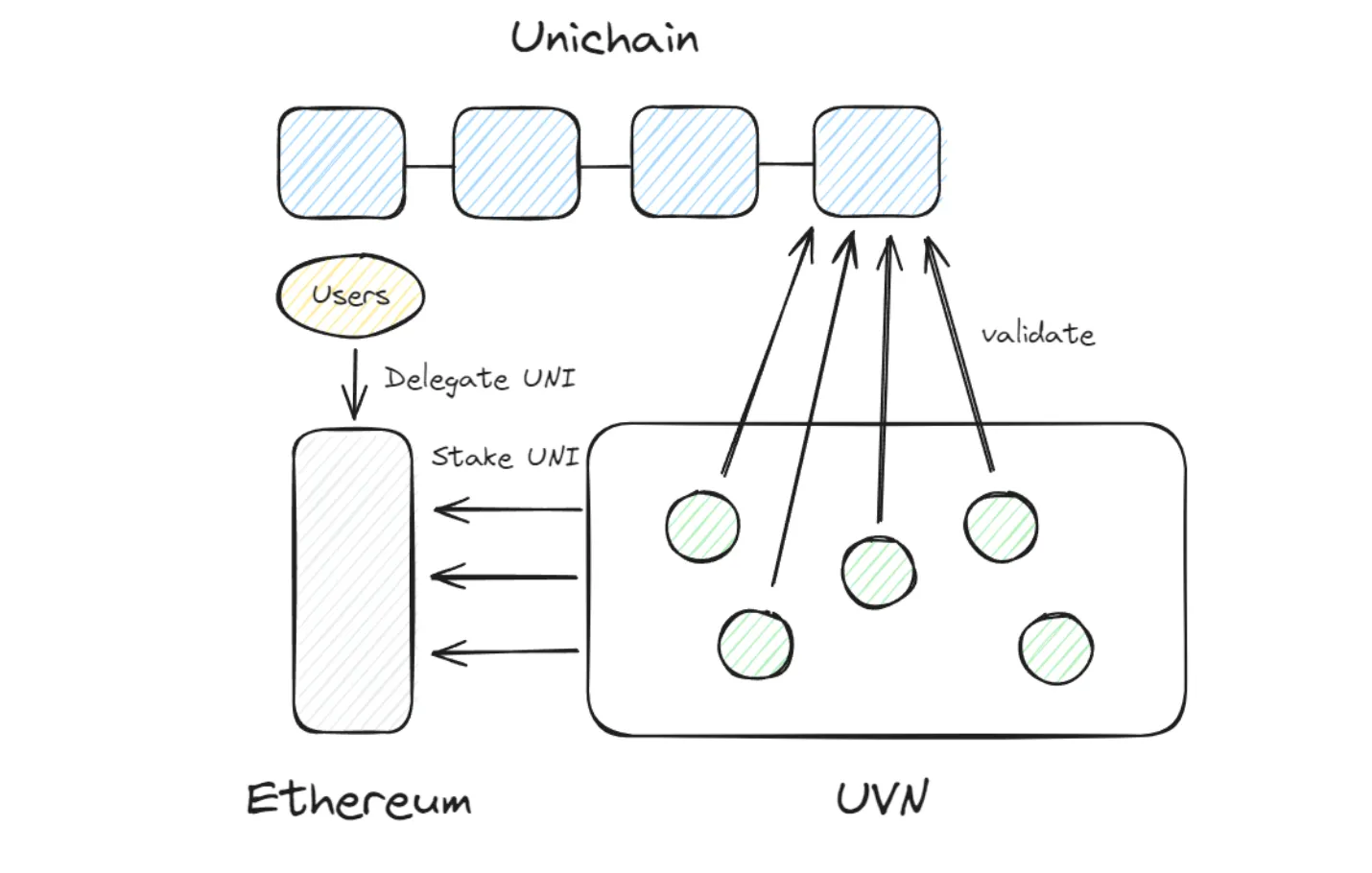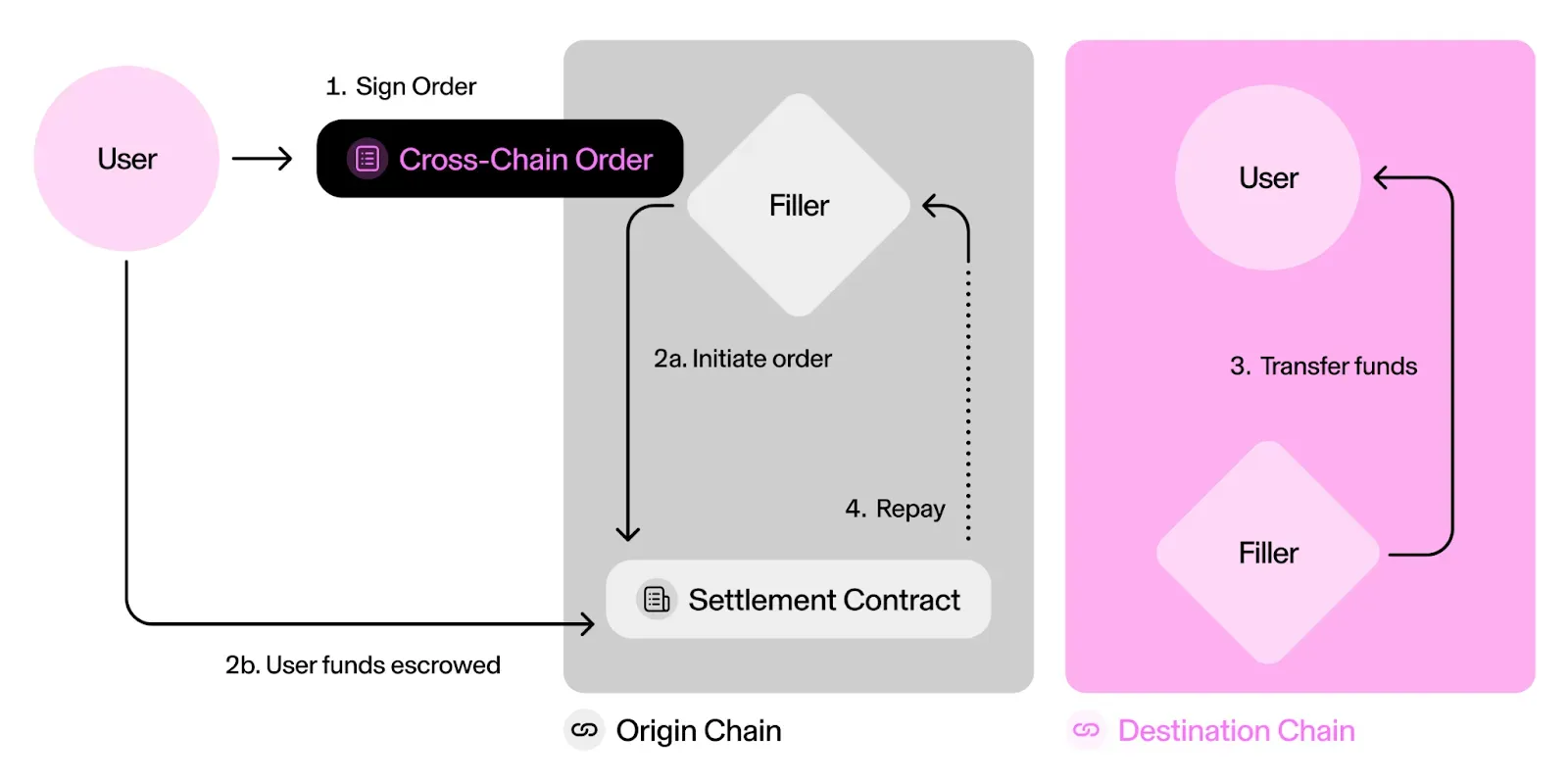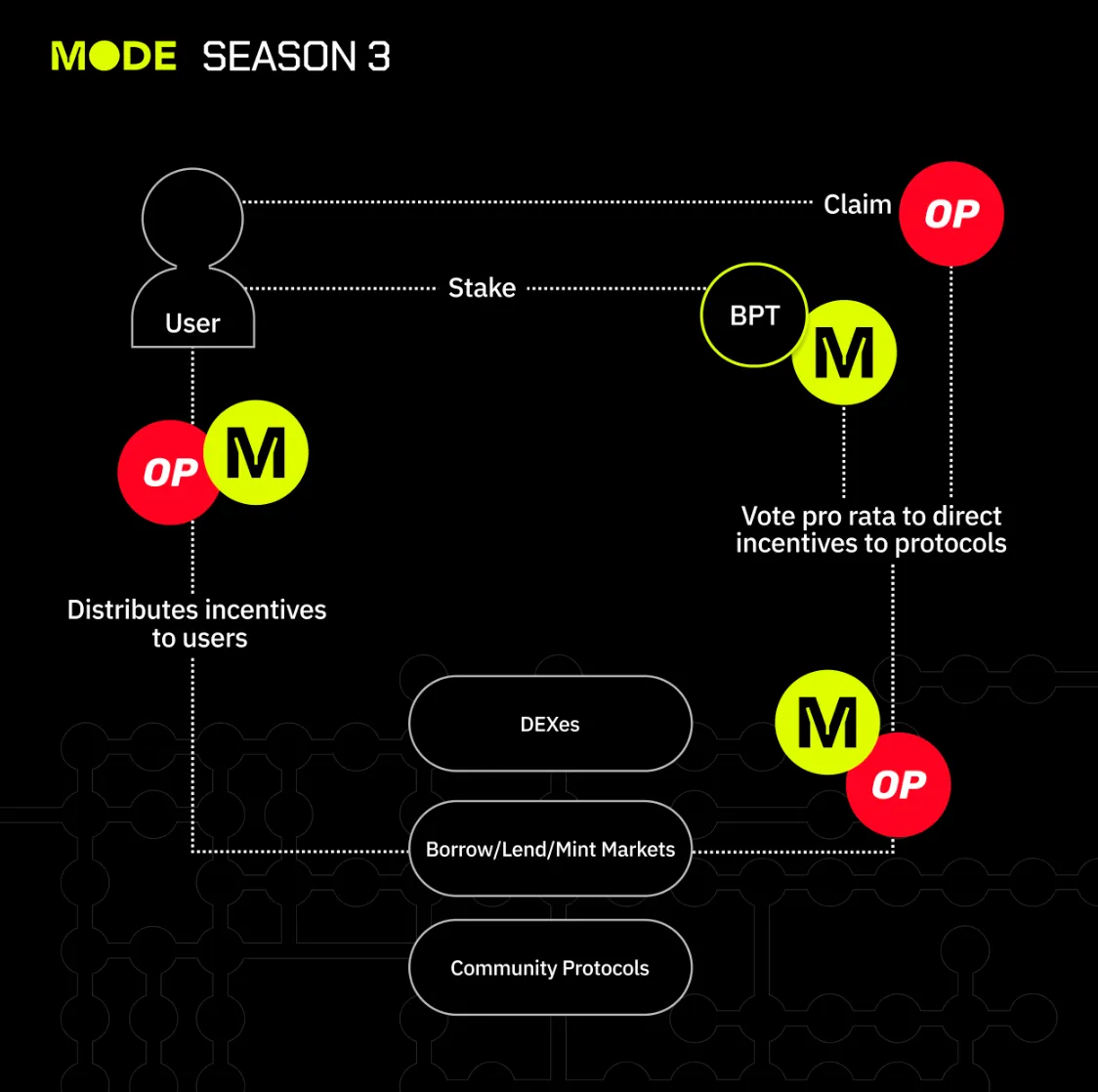Unichain has solidified several possibilities we've been anticipating. A notable trend is that large-scale apps are expanding to control the entire stack—from applications (Uniswap Wallet, Front-end + Uniswap X) and protocols (Uniswap V2, V3, V4) to chains (Unichain). Apps are no longer just remaining as applications; they're venturing into chain operation for better economic control, block space management, and seamless user experience. This evolution supports the "Fat App" thesis, which explains these developments. (For more on Unichain and Fat App, see our previous opinion piece)
Beyond the discussion of apps, another change that Unichain demonstrates can be found in L2 tokenomics. Unichain has introduced staking functionality for $UNI through the UVN (Unichain Validation Network), enhancing the value of $UNI. In fact, $UNI, Uniswap's native token, has long been considered an exemplar of a 'useless' token. This is due to its limited utility, having only governance voting functions, in contrast to Uniswap's substantial protocol revenue. How is Unichain adopting methods to enhance the value of $UNI? And how can Unichain's moves accelerate changes in L2 tokenomics? Let's examine these questions below.

Source: Uniswap, Flashbots, and OP-Stack: The Trinity Behind Unichain - 100y
One of the key features of Unichain is the UVN (Unichain Validation Network). UVN is a network of node operators that independently verify the blockchain state, implemented for 'preconfirmation' of transactions. When a new block is created on Unichain, the multiple validator set of UVN attests to the canonical chain. This allows Unichain to partially guarantee the finality of self-generated transactions, minimizing the security risks that could be caused by a single sequencer and helping Unichain to process cross-chain transactions reliably.

Source: X(@Uniswap)
Unichain is making active efforts to create chain-agnostic liquidity flows. As part of this effort, it aims to implement cross-chain message delivery between Superchain L2s using the native interoperability of the Optimism Superchain. For other chains, Unichain has proposed ERC-7683 with Across Protocol to standardize cross-chain intents, focusing on improving interoperability across all chains.
However, the single sequencer structure adopted by most L2s can be a significant obstacle in implementing a chain-agnostic 'Liquidity Network.' In L2 blockchains, the sequencer is responsible for bundling user transactions sent to the mempool and deciding in what order to include them in blocks.
Currently, most rollups use a single sequencer, with the network's operating entity arbitrarily taking on the role of sequencer. This single sequencer structure can cause problems for the cross-chain transaction infrastructure that Unichain is trying to build in the following ways:
Block Equivocation Risk: The sequencer might submit multiple blocks with the same height, creating uncertainty about which block should be finalized on Ethereum, the base layer.
Invalid Block Risk: If a fault proof is later submitted for an invalid block, it may require rolling back the chain, delaying cross-chain settlement.
To prevent these problems, Unichain introduces UVN, which independently verifies the state of the chain on L2. Before transactions are finally confirmed on Ethereum, the base layer, Unichain uses its own economic security implemented through UVN to preconfirm the validity of transactions.
UVN expands $UNI's utilities, which was previously seen as having limited usage. This is achieved by employing it to secure economic stability in the preconfirmation of Unichain-generated blocks. To become a UVN validator, users must stake $UNI on the Ethereum mainnet. Each epoch selects the nodes with the highest staked $UNI balances as active validators. Validators running a Reth Unichain node earn rewards based on their staked tokens when they submit valid proofs. $UNI holders can also earn rewards by delegating their stakes to these validator nodes.
This system provides $UNI with a value acquisition mechanism from Unichain, expanding its role beyond governance voting. A key lesson from L2 tokens is the necessity of linking network activity to token demand and supply, regardless of network popularity. Unichain addresses this by designing its $UNI staking function to increase rewards for validators and delegators as Unichain transaction volume grows.
While the long-term effects of this design remain to be seen, $UNI staking could potentially reduce token circulation and incentivize long-term holding. This approach aligns the interests of UVN validators, $UNI holders, and Unichain operators towards the shared goal of network growth and activation.
Like Unichain, various Layer 2s are boosting their native tokens' utility to drive market demand and encourage long-term holding. How do L2s enhance token utility? The approach mirrors the evolution of Layer 1 and DeFi protocol tokenomics. Unichain, for instance, introduced UVN for smooth cross-chain swaps and added $UNI staking to build economic security. Similarly, each L2 develops unique tokenomics aligned with its mission and architectural focus. Mode, Taiko, and Arbitrum offer prime examples of these developments, which we'll explore next.
2.1.1 Mode - Aligning Interests through Introduction of DeFi Mechanisms

Source: Mode Blog
As a member of the Superchain ecosystem, Mode receives OP grants, and in the process of distributing these grants to the ecosystem, it uses the ve (Voting Escrow) model to coordinate the interests of ecosystem participants and strengthen the utility of its native token, $MODE. Holders of veMODE, which is obtained by staking $MODE, can earn $OP as rewards in each defined epoch. Additionally, veMODE holders can participate in gauge voting to determine which protocols in the Mode ecosystem (such as DEX, Lending Market, etc.) will receive incentives ($OP, $MODE), potentially leading to the emergence of a bribe market where protocols provide economic incentives to attract user votes.
2.1.2 Taiko - Deposit for Competitive Validity Proofs
Taiko has newly introduced Based Contestable Rollup (BCR) in its sequencing process. According to BCR, for a new proposer B to challenge a block proposed by the existing prover A, they must stake a validity bond in $TAIKO. If the new proposer B makes an incorrect modification proposal, their validity bond is confiscated, and the existing proposer A, who made the correct proposal, receives the reward. Conversely, if B makes a valid challenge, they receive additional rewards for successful proof. In this way, Taiko implements a competitive rollup proof mechanism using validity bonds to prepare for the possibility of incorrect proofs, while simultaneously ensuring that $TAIKO plays an important role in the network's sequencing process.
(For more details on Taiko and BCR, refer to the Taiko report)
2.1.3 Arbitrum - Protocol Revenue Redistribution & MEV Auction Bidding
Arbitrum DAO recently passed a proposal to introduce staking functionality for $ARB, with the core idea being to activate token utility by creating a system for delegating governance authority and associated rewards through $ARB staking. If the proposal is implemented, users will be able to stake $ARB and then receive interest from various revenue sources such as sequencer fees, MEV fees, and validator fees. Moreover, by introducing liquid staking, users can maximize capital efficiency by interoperating $stARB with other DeFi protocols while maintaining their $ARB staking status.
In addition, a Time Boost proposal was put forward to burn $ARB through MEV auctions. This proposal suggests adding an auction method that allows capturing MEV opportunities by auctioning off the right to arbitrarily determine the order of transactions, in addition to the existing First Come First Serve (FCFS) transaction processing system. In this case, the proposal included an option for bidders to bid with $ARB to participate in the auction and burn the $ARB once the bidding is completed (similar to Injective's burn auction mechanism). Although it was ultimately decided to use $ETH instead of $ARB as the bidding asset and accumulate the completed $ETH bids in the DAO treasury, it's noteworthy as an idea proposed to capture value for L2 tokens.
Looking at various examples, including Unichain's UVN, the trend of L2s strengthening the utility of their native tokens can be summarized as follows:
Network Revenue Redistribution (e.g., $ARB Staking): Along with token staking functionality, redistributing various revenue sources generated by the network
MEV Auctions (e.g., Arbitrum TimeBoost): Strengthening token utility by using tokens as the asset for MEV bidding, and linking it to a burn mechanism to adjust supply
Introducing DeFi Mechanisms (e.g., $veMODE): Borrowing mechanisms used in DeFi protocols, such as voting escrow, to strengthen economic connectivity among ecosystem participants and diversify incentive distribution methods
Sequencing (e.g., Unichain UVN, Taiko BCR): Creating token utility while securing security by using tokens for staking to qualify as validators or as collateral for challenges in the process of arranging and processing blocks
I think the diversification of L2 tokenomics is a significant step forward. Previously, most L2 tokens were limited to governance voting, lacking essential market demand and stable value. This led to ongoing price drops, which threatened L2 DAOs' economic security and fostered negative market perceptions, despite the technical merits or Ethereum-expansion goals of L2s. Unichain's renewed focus on diversifying L2 tokenomics is crucial. It drives changes that boost L2 token value, paving the way for a more advanced L2 ecosystem.

Source: X(@0xfishylosopher)
Criticism of Unichain is not absent. While attention was focused on the utility $UNI gained with the announcement of Unichain-related content, behind the scenes, there was criticism that the discussion of the Fee Switch, which had been ongoing for years, was tentatively excluded. The Fee Switch is a plan to distribute Uniswap's protocol revenue to $UNI holders who stake their tokens. In March of this year, the Fee Switch proposal was reignited but was temporarily postponed again due to regulatory concerns. In this context, when the $UNI staking function of UVN, which redistributes validator revenue without mentioning protocol fee distribution, was announced, it sparked backlash from the community. Regarding the Fee Switch, there is a need for continued multi-faceted discussions, evaluations, and communication with the community, along with Unichain's initiatives.
Uniswap Labs Blog: https://blog.uniswap.org/uni
Unichain Whitepaper: https://docs.unichain.org/whitepaper.pdf
Mode Blog: https://t.co/v6BmBGKsUa
Arbiturm DAO: https://forum.arbitrum.foundation/t/arb-staking-unlock-arb-utility-and-align-governance/25084
Taiko Blog: https://taiko.mirror.xyz/Z4I5ZhreGkyfdaL5I9P0Rj0DNX4zaWFmcws-0CVMJ2A
Dive into 'Narratives' that will be important in the next year